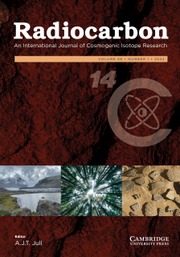No CrossRef data available.
Article contents
Estimation of travertine formation age in northwestern Iran using radiocarbon and stable isotopes
Published online by Cambridge University Press: 04 November 2025
Abstract
Travertine is widely distributed in northwestern (NW) Iran and Turkey and serves as a valuable sample for paleoenvironmental reconstructions in semi-arid areas. Previous studies have analyzed the chemical compositions, carbon and oxygen isotopes of the travertines in NW Iran for paleoenvironmental reconstructions, but little dating has been done because travertine 14C dating faces the problem of identifying the initial 14C concentration of each sample. The objective of this study is to determine the formation age of travertine in NW Iran using radiocarbon (14C) and δ13C from a travertine mound and its related spring water. Travertine samples were collected from the base to the top of a cone-shaped travertine mound, Zendan-e Soleyman, in the Takab region of NW Iran. The 14C concentrations of the travertine samples ranged from 0.67 to 3.72 pMC, with values fluctuating considerably and higher 14C being observed at higher elevations. The δ13C values were lower at higher elevations (+10.1 to +7.4‰) with fluctuations. The values suggest that the travertines were formed through the decarbonation of limestone and rapid degassing. The dissolved inorganic carbon (DIC) of nearby spring water samples had 14C concentrations of about 10.4 pMC, about 89.6% dead carbon fraction (DCF), and δ13C value of +1.3‰. These values indicate that one of the of CO2 sources in the travertine-deposited spring water was of hydrothermal origin. Considering the DCF of the spring water DIC, the formation of the travertine mound began about 20 kyr BP, and the growth of the mound ended about 7 kyr BP.
Keywords
Information
- Type
- Conference Paper
- Information
- Copyright
- © The Author(s), 2025. Published by Cambridge University Press on behalf of University of Arizona
Footnotes
Selected Papers from the 4th Radiocarbon in the Environment Conference, Lecce, Italy, 23–27 Sept. 2024


